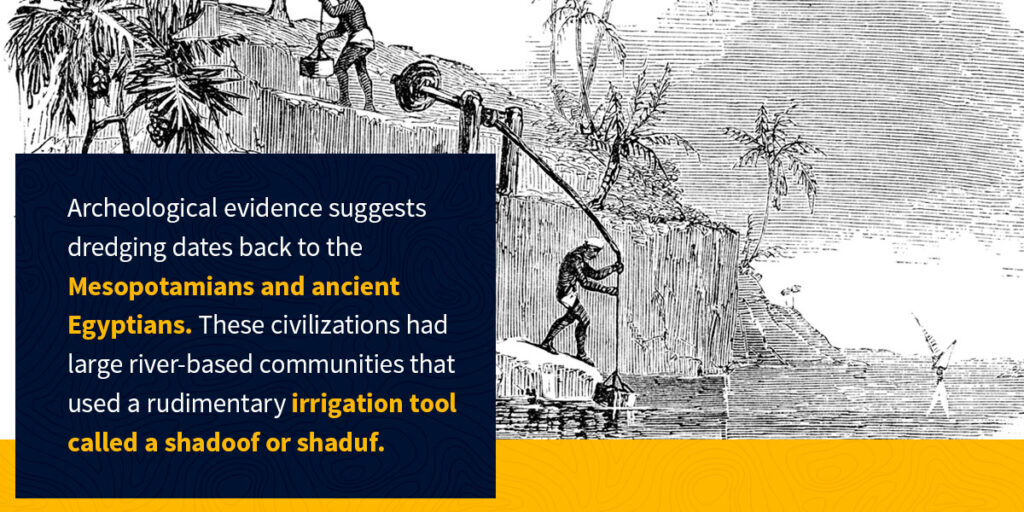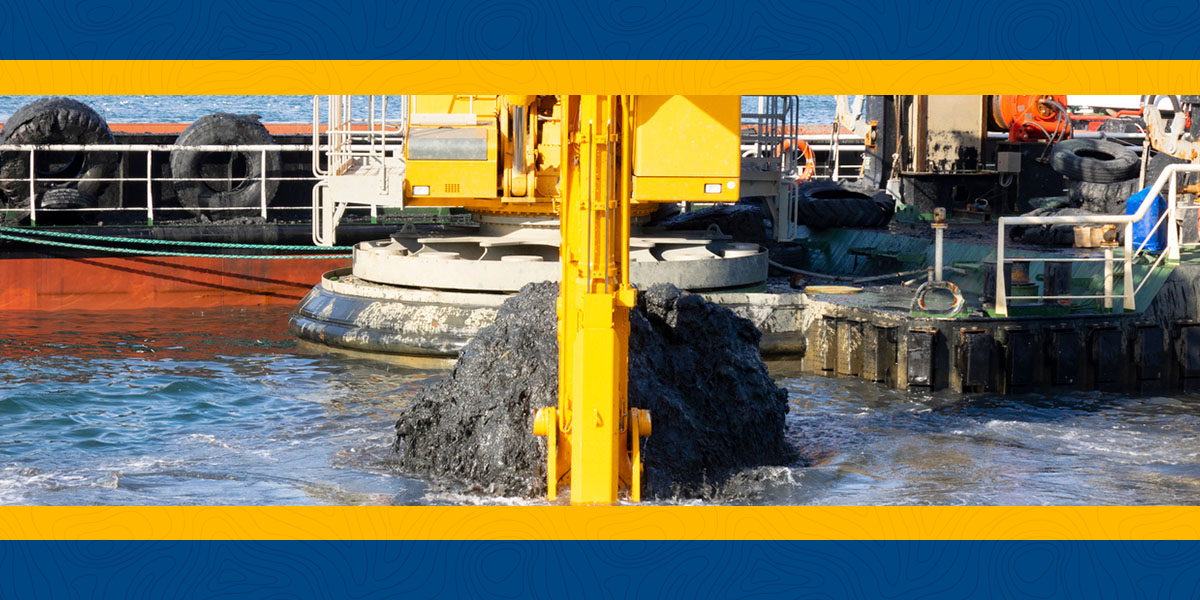Dredging is a process that removes sediments and artificial debris from the bottom of freshwater bodies and shallow seawater. Various industries use dredging to excavate materials from the bottom of waterways, including rocks, refuse, contaminants, building debris and plants. The process makes water navigable, creates an adequate environment for building dams and constructing bridges and even makes it possible to recover minerals and marine life where they have commercial uses.
Dredging dates back centuries. Ancient civilizations used crude resources like buckets to lift sediments from riverbeds. In modern times, we use a specialized boat called a dredger. There are different types of dredgers — hydraulic and mechanical.
Keep reading to learn more about dredging history and how this technology has evolved.
The Beginning of Dredging
Dredging is steeped in humble beginnings and has come a long way when we compare it to current processes. Most early civilizations established themselves on rivers, making it crucial for them to be able to navigate these bodies of water. Ancient peoples from around the world developed unique, innovative solutions to contend with the environment.

Ancient Civilizations
Archeological evidence suggests dredging dates back to the Mesopotamians and ancient Egyptians. These civilizations had large river-based communities that used a rudimentary irrigation tool called a shadoof or shaduf. The shadoof suspends a long pole with a bucket or basket on the end from a frame. Inhabitants would lower the bucket into water, lift it and place it in another water source or on land.
Furthermore, archeologists have found evidence of dredging in ancient Roman harbors. Romans, known for their advanced engineering projects like the aqueduct, likely used dredging to build canal gates to control water traffic and flow.
Dredging in the Modern Era
Renowned Renaissance artist and inventor Leonardo da Vinci drew a design for a type of drag dredger around the 16th century. A few hundred years later, the Industrial Revolution began and marked noteworthy advancements in dredging techniques, including the beginning of motorized dredging. The invention of the steam engine in the 18th and 19th centuries led to the use of motorized steamboats. This new technology made dredging easier and far more effective than at any other time in dredging history. From there, dredging took off and was pivotal in land development and building and expanding ports and canals.
In the early 20th century, dredging was also crucial for land reclamation, or constructing new land in the sea. For example, in 1932 the Dutch government drained the Zuiderzee, a shallow part of the North Sea bordering the Netherlands. Cutting this off from the North Sea made it possible to reclaim the shallow wetlands and led to the creation of the Flevopolderin, an island polder and one of its surrounding lakes, the IJsselmeer.
Dredging techniques became more innovative and hydraulic dredging, which uses streams of pressurized water to remove sediment, increased in popularity during the 20th century.
The Present of Dredging
The dredging industry today is one of continued innovation. Many present industrial developments highlight new and renewed interest in environmental considerations. This spurred further innovation as developers found ways to make dredging safer and more sustainable.
Today, a branch of dredging known as environmental dredging removes contaminated sediment from underwater. The process is also used to treat these waters or to place the contaminated sediments in a new location. Environmental dredging helps reduce the risks associated with underwater contaminants for human and ecological health.
Technological advancements continue to make dredging operations as accurate as possible. We now have software for real-time monitoring and improved surveying and mapping techniques. These resources are crucial as they minimize the chances of environmental impact all while making dredging as efficient as possible.
Dredging is now a significant part of an extensive industry. Governments, corporations and individual pioneers use state-of-the-art dredging equipment in large-scale projects, including offshore energy initiatives, land reclamation and the development and maintenance of ports and canals.
The Future of Dredging
There is a rise in demand for highly specialized dredging equipment and techniques following an increase in dredging activities commercially and environmentally. Governments have more contracts for various infrastructure projects in place and bidding for these tenders is competitive.
The ambitious market is an incredible driving tool for innovation — we will likely see breakthroughs in dredging equipment and techniques that make the entire process more customizable and efficient. New styles and designs will also become more prevalent as the demand for an efficient dredging operation grows and as the benefits of dredging become more apparent.
For example, a recent study analyzing dredging practices on the Gulf Coast shows the beneficial use of dredged sediment to correct land and habitat loss. The study reports that large amounts of sediment is dredged from the Gulf Coast annually to maintain safe waterways. This sediment is a valuable resource in restoring coastal marsh habitats and has led to the creation of 800 hectares of new land in the Mississippi River Delta.
Sea-borne trade is also on the rise, and this may cause the dredging market to boom even more. Sea-borne trades don’t only require well-maintained waterways — as the industry grows, there will be an increasing need for expanding ports and building new ports and waterways.
If the industry follows current trends, the dredging market could grow to $14.39 billion by 2027.
The Present and Future of Dredging With GeoForm International
Dredging is the perfect example of how simple ideas and solutions can grow into revolutionary industries. The rudimentary technique of a bucket suspended from a pole has transformed into a billion-dollar market that requires expert engineering and a mind for the future commercially and environmentally. GeoForm International Inc. envelops this ethos and we provide you with premium dredging equipment for your industry needs.
Our Dino 6 Sediment Removal System is a portable hydraulic dredge packed with power. The system is equipped with a 6-inch submersible pump and 66-inch-wide cutterhead, while a four-cylinder diesel engine powers the craft. At slightly over 22 feet long, 6 feet wide and less than 6 feet tall, this small boat is perfectly portable.
The Dino 6 is ideal for projects that are inaccessible with bigger equipment. You can use the Dino 6 for maintaining golf courses and small marinas. It is also a powerful tool for homeowners associations. Our high-quality submersible pumps are proudly made in the USA.
Keep up with industry trends with the Dino6! Contact GeoForm International today to learn more about our Dino 6 dredge and submersible pumps.


